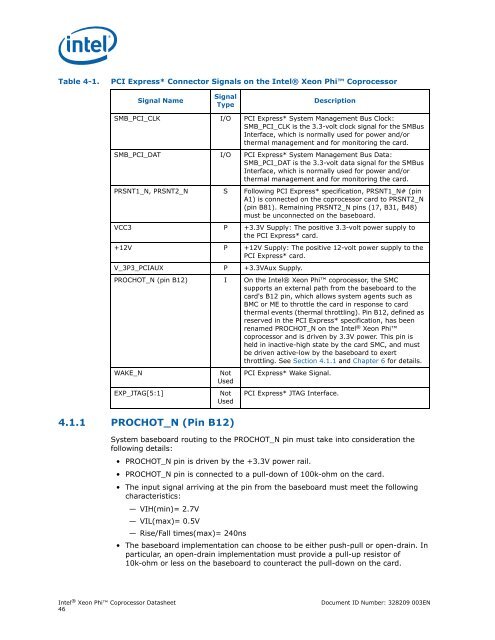Xeon-Phi-Coprocessor-Datasheet
Xeon-Phi-Coprocessor-Datasheet
Xeon-Phi-Coprocessor-Datasheet
Create successful ePaper yourself
Turn your PDF publications into a flip-book with our unique Google optimized e-Paper software.
Table 4-1.<br />
PCI Express* Connector Signals on the Intel® <strong>Xeon</strong> <strong>Phi</strong> <strong>Coprocessor</strong><br />
Signal Name<br />
Signal<br />
Type<br />
Description<br />
SMB_PCI_CLK I/O PCI Express* System Management Bus Clock:<br />
SMB_PCI_CLK is the 3.3-volt clock signal for the SMBus<br />
Interface, which is normally used for power and/or<br />
thermal management and for monitoring the card.<br />
SMB_PCI_DAT I/O PCI Express* System Management Bus Data:<br />
SMB_PCI_DAT is the 3.3-volt data signal for the SMBus<br />
Interface, which is normally used for power and/or<br />
thermal management and for monitoring the card.<br />
PRSNT1_N, PRSNT2_N S Following PCI Express* specification, PRSNT1_N# (pin<br />
A1) is connected on the coprocessor card to PRSNT2_N<br />
(pin B81). Remaining PRSNT2_N pins (17, B31, B48)<br />
must be unconnected on the baseboard.<br />
VCC3 P +3.3V Supply: The positive 3.3-volt power supply to<br />
the PCI Express* card.<br />
+12V P +12V Supply: The positive 12-volt power supply to the<br />
PCI Express* card.<br />
V_3P3_PCIAUX P +3.3VAux Supply.<br />
PROCHOT_N (pin B12) I On the Intel® <strong>Xeon</strong> <strong>Phi</strong> coprocessor, the SMC<br />
supports an external path from the baseboard to the<br />
card's B12 pin, which allows system agents such as<br />
BMC or ME to throttle the card in response to card<br />
thermal events (thermal throttling). Pin B12, defined as<br />
reserved in the PCI Express* specification, has been<br />
renamed PROCHOT_N on the Intel ® <strong>Xeon</strong> <strong>Phi</strong><br />
coprocessor and is driven by 3.3V power. This pin is<br />
held in inactive-high state by the card SMC, and must<br />
be driven active-low by the baseboard to exert<br />
throttling. See Section 4.1.1 and Chapter 6 for details.<br />
WAKE_N<br />
EXP_JTAG[5:1]<br />
Not<br />
Used<br />
Not<br />
Used<br />
PCI Express* Wake Signal.<br />
PCI Express* JTAG Interface.<br />
4.1.1 PROCHOT_N (Pin B12)<br />
System baseboard routing to the PROCHOT_N pin must take into consideration the<br />
following details:<br />
• PROCHOT_N pin is driven by the +3.3V power rail.<br />
• PROCHOT_N pin is connected to a pull-down of 100k-ohm on the card.<br />
• The input signal arriving at the pin from the baseboard must meet the following<br />
characteristics:<br />
— VIH(min)= 2.7V<br />
— VIL(max)= 0.5V<br />
— Rise/Fall times(max)= 240ns<br />
• The baseboard implementation can choose to be either push-pull or open-drain. In<br />
particular, an open-drain implementation must provide a pull-up resistor of<br />
10k-ohm or less on the baseboard to counteract the pull-down on the card.<br />
Intel ® <strong>Xeon</strong> <strong>Phi</strong> <strong>Coprocessor</strong> <strong>Datasheet</strong><br />
46<br />
Document ID Number: 328209 003EN


